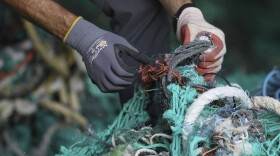The U.S. Navy is now considering double-wall tanks for its fuel storage in Red Hill and says it will relocate the facility if that upgrade can't be done.
Although that is welcome news for Honolulu officials, City Council members and the Board of Water Supply still have concerns.
On Wednesday, the council heard presentations from the Navy and Board of Water Supply on the proposed storage tank upgrades before adopting a resolution reiterating its stand for better improvements to the Navy’s Red Hill facility.
In 2014, 27,000 gallons of fuel leaked out of the underground facility threatening Oahu drinking water aquifers. City officials and residents have been calling for changes ever since.
Up until this point, the Navy favored single-wall tank upgrades with added monitoring features. That has not been the council’s or the Board of Water Supply’s preference for a "tank-within-a-tank" alternative.
But Capt. Marc Delao told council members that after working with regulators and the state, the Navy is now committed to exploring a secondary or double-wall containment option, although it will take work to accomplish.
"Really, the change is that commitment of pursuing a secondary containment solution that is not available today. But let us pursue that, using innovation, using research, using select investments, academia and industry – to see if we can do that.
"And if that becomes mission impossible, or unattainable – not available, not practicable – then, again, what has changed is that commitment that we will de-fuel and get off the aquifer around 2045," Delao said.
Board of Water Supply Chief Engineer Ernie Lau said he appreciated the Navy’s new commitment. But he expressed concerns about what the Navy defines as a secondary containment system – and its timetable.
"Secondary containment is actually practicable. It can be done. It is a matter of will, and also how many dollars do you want to spend on doing that," Lau said.
Then he added: "[The year] 2045 is too far away. Time is our enemy here. The rust on that quarter-inch steel plate doesn’t stop for us. And the more the rust penetrates through the steel plate, and it has already, more fuel will leak out of that facility as it gets older and older."
Ultimately, the state Department of Health and the U.S. Environmental Protection Agency will decide which upgrades the Navy will have to complete.
If there is a disagreement among the two parties, the EPA’s decision will override the health department's.
The Navy's shift comes as a Nov. 19 public meeting approaches on the proposed upgrades while a separate event is planned later this year on rule changes that would toughen standards for underground storage tanks.
The first meeting, scheduled by the Department of Health and Environmental Protection Agency, is set for 6 p.m., Nov. 19, at Moanalua Middle School.
The Department of Health has also scheduled a public meeting at 9 a.m., Dec. 2, at the agency's State Laboratory Auditorium, 2725 Waimano Home Rd. in Pearl City, to discuss proposed changes in administrative rules governing underground storage tanks.
The proposed rule changes would require underground systems to either have secondary containment, such as a tank-within-a-tank, by July 15, 2045 or be moved above ground.




